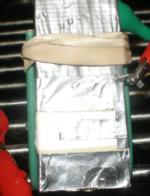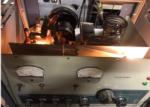
Posted By: Robert Nickels (ranickels) Posted: 03/30/2022 Technical 03/30/2022 |
DIY DEG - Homemade Droplet Energy Generator works!Producing electricity from flowing water |
|
I'm not ready to publish a description of exactly HOW it works, but 20 minutes effort with scissors and tape produced a prototype Droplet Energy Generator that allows me to say for sure that IT WORKS! I duplicated the design shown in this video. I wrapped a scrap of plastic in aluminum foil, then applied a strip of double-sided tape and to that attached a piece of PTFE thread-locking tape (a 260" x 1/2" roll sells for 53 cents at the hardware store). I then applied duct tape to provide an insulated handle and a narrow strip to insulate the contact which I cut from aluminum tape (used for sealing joints in ductwork). All in all the cost of materials is a few pennies! A multimeter was attached to the two foil contacts and drops of water applied - voila! A few dozen millivolts resulted. It became clear that creating a stream of droplets was the hardest part of the experiment so I took it to the kitchen sink, set the faucet to as small a stream as I could, and here is the result VIDEO The small trickle of water produced a fairly consistent voltage in excess of 1/10th of a volt. Now who would have bet that was possible before watching and reading this article? What's going on here? One thing that is well understood is that raindrops carry an electric charge. Another is that PTFE has a number of desirable properties:
Polytetrafluoroethylene (PTFE) is a synthetic fluoropolymer of tetrafluoroethylene that has numerous applications. It was accidentally discovered in 1938 by Roy J. Plunkett while he was working in New Jersey for DuPont. As Plunkett attempted to make a new chlorofluorocarbon refrigerant, the tetrafluoroethylene gas in its pressure bottle stopped flowing before the bottle's weight had dropped to the point signaling "empty." Since Plunkett was measuring the amount of gas used by weighing the bottle, he became curious as to the source of the weight, and finally resorted to sawing the bottle apart. He found the bottle's interior coated with a waxy white material that was oddly slippery. Analysis showed that it was polymerized perfluoroethylene, with the iron from the inside of the container having acted as a catalyst at high pressure. PTFE's Its extremely high bulk resistivity makes it an ideal material for fabricating long-life electrets - materials that carry a semi-permanent electrical charge, the electrostatic analog to a permanant magnet. (In fact the name electret was coined by Oliver Heavyside 1885 by combining the words electron and matnet). In this case, this seems to be the critical property for the "rain fuel generator". When the tiny charge of electricity on a water droplet contact most materials it dissipates quickly but as a very good insulator, the PTFE which also carries a small permanent electrical charge acts to concentrate the charge until the conductive water droplet bridges a second electrical contact that causes it to discharge. The researchers make a comparison to the water acting like the gate of a FET, causing a burst of current to flow when it is turned on. That's as much theory as I care to speculate on at this point but to say this is an exciting technology that is being researched all over the world is no exaggeration. The original paper appeared in the prestigious journal NATURE in 2020 and a preview can be seen HERE
|
|
Latest Articles
|
Crystal Replacement
Posted: 02/38/2024
Comments: 0 |
How good can a crummy receiver be?
Hundreds of different simple SDR receivers have been designed around Dan Tayloe's Quadrature Sampling Detector or QSD. Mine add nothing to the state of the art, and in fact subtract things, as I like minimalist solutions and the QSD is right in that sweet spot. Following the evolution of Tayloe's design I delete the resistors in series with the sample lines for inst... READ MORE |

Technical
Posted: 02/37/2024
Comments: 0 |
What's in a number (3253)?
The FST3253 dual four-to-one mux/demux IC has long been used as a "Tayloe Detector" or QSD (and QSE) in low-cost SDRs. They provide incredible performance for such a simple circuit, converting RF to baseband IQ with low loss and the ultimate in simplicity. Unfortunately the original FST3253 part has become obsolete and while substitutes are available, this is where the... READ MORE |

Vintage Ham Radio
Posted: 02/32/2024
Comments: 0 |
The Stancor 10P Transmitter
There weren't really many commercial transmitters in the 1930s as most hams built their own. But many of the ones that were offered came from the transformer companies who had two chances to profit. First, from those who would buy the kit, and two, from those would would see it in the (free) booklets the companies provided to their distributors who would then sell the iron to ham... READ MORE |

Vintage Ham Radio
Posted: 12/355/2023
Comments: 0 |
The Care and Feeding of the EF Johnson Courier amplifier
The EF Johnson "Courier" is a grid-driven amplifier using two 811A tubes. Switching is provided for operating in either class C for CW or as a class B linear amplifier for AM or SSB. Rated power is 500 watts input for CW, 500 watts PEP input for SSB, and 200 watts input for double-sideband AM with carrier. Since all amateur power levels were meas... READ MORE |

Historic
Posted: 11/329/2023
Comments: 0 |
TV Duplexer
Some things are interesting, even if totally useless nowadays. Such is the case with the Philco 426-3034 Crossover Kit for UHF TV. What the heck is that? Well, back in the late 50s, UHF television stations operating on channels 14-83 started to appear in many areas of the US where viewers had a VHF-only TV antenna, and in many cases an externa UHF converter was... READ MORE |

Crystal Replacement
Posted: 11/327/2023
Comments: 0 |
Replacing failed crystals
For decades, quartz crystals were used everywhere a stable frequency source was needed, even in some applications that depended on overtone (harmonic) behavior into the VHF range. These crystals were less stable and more dependent on circuit parameters that fundamental types and thus more problematic. Such was the case with the 94 MHz crystal in the 2 meter converter ... READ MORE |

Historic
Posted: 11/315/2023
Comments: 0 |
My Own Ham Radio Story by W9RAN
Everyone has a story of how they got involved in ham radio - this is mine. It started much earlier, including receiving a Knight Kit Span Master shortwave radio for Christmas in about 1963, at age 12. I'll never forget the night my dad and I finished building it and I wanted to try it out. It came with a 50 ft. antenna which was still coiled up - but ... READ MORE |

Technical
Posted: 09/267/2023
Comments: 0 |
Hot to simulate vacuum tubes in LTSpice
LTSice is a powerful simulation tool that is provided free by Linear Technology Corp. It comes with a complete library of passive and common analog solid-state components but if you want to use it to simulate vacuum tubes, it doesen't work as-is. Even though triode and pentode symbols can be found in the "Misc" folder, they are just schematic symbols and... READ MORE |

Friends Remembered
Posted: 07/208/2023
Comments: 0 |
Merv Schweigert, K9FD (SK)
Comments from Robert Nickels W9RAN, July 27, 2023: There is nothing worse for a ham radio operator than to see a beloved friends callsign with the letters "SK" behind them. Yet sadly, that's what happened on July 23, 2023, when I learned of the passsing of Merv Schweigert, K9FD. While many of our ham radio interests were different - Me... READ MORE |

Vintage Ham Radio
Posted: 01/19/2023
Comments: 0 |
"Winter Projects"
I know many of us who enjoy restoring and repairing vintage gear look forward to winter when there is less competition for time and energy, and a chance to really make a dent in our "to be fixed" piles. A couple of years ago I set time aside for "Heathkit Singlebander Week" and went through every one of them I had, with the result that they're all working ... READ MORE |